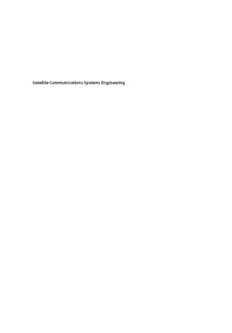Table Of Content(cid:2)
SatelliteCommunicationsSystemsEngineering
(cid:2) (cid:2)
(cid:2)
(cid:2)
Satellite Communications Systems Engineering
AtmosphericEffects,SatelliteLinkDesignandSystemPerformance
LouisJ.Ippolito,Jr.
EngineeringConsultantandAdjunctProfessor,
(cid:2) TheGeorgeWashingtonUniversity, (cid:2)
WashingtonDC,USA
SecondEdition
(cid:2)
(cid:2)
Thiseditionfirstpublished2017
©2017JohnWiley&SonsLtd
Allrightsreserved.Nopartofthispublicationmaybereproduced,storedinaretrievalsystem,or
transmitted,inanyformorbyanymeans,electronic,mechanical,photocopying,recordingorotherwise,
exceptaspermittedbylaw.Adviceonhowtoobtainpermisiontoreusematerialfromthistitleisavailableat
http://www.wiley.com/go/permissions.
TherightofLouisJ.Ippolito,Jr.tobeidentifiedastheauthorofthisworkhasbeenassertedinaccordance
withlaw.
RegisteredOffices
JohnWiley&SonsLtd,TheAtrium,SouthernGate,Chichester,WestSussex,PO198SQ,UK
EditorialOffice
(cid:2) (cid:2)
TheAtrium,SouthernGate,Chichester,WestSussex,PO198SQ,UK
Fordetailsofourglobaleditorialoffices,customerservices,andmoreinformationaboutWileyproducts
visitusatwww.wiley.com.
Wileyalsopublishesitsbooksinavarietyofelectronicformatsandbyprint-on-demand.Somecontentthat
appearsinstandardprintversionsofthisbookmaynotbeavailableinotherformats.
LimitofLiability/DisclaimerofWarranty
Whilethepublisherandauthorshaveusedtheirbesteffortsinpreparingthisbook,theymakeno
representationsorwarrantieswithrespecttotheaccuracyorcompletenessofthecontentsofthisbookand
specificallydisclaimanyimpliedwarrantiesofmerchantabilityorfitnessforaparticularpurpose.No
warrantymaybecreatedorextendedbysalesrepresentativesorwrittensalesmaterials.Theadviceand
strategiescontainedhereinmaynotbesuitableforyoursituation.Youshouldconsultwithaprofessional
whereappropriate.Neitherthepublishernorauthorsshallbeliableforanylossofprofitoranyother
commercialdamages,includingbutnotlimitedtospecial,incidental,consequential,orotherdamages.
LibraryofCongressCataloging-in-PublicationDataappliedfor
ISBN:9781119259374
Coverimage:Jeff_Hu/Gettyimages;ILYAGENKIN/Shutterstock
CoverdesignbyWiley
AcataloguerecordforthisbookisavailablefromtheBritishLibrary.
Setin10/12ptWarnockbySPiGlobal,Chennai,India
10 9 8 7 6 5 4 3 2 1
(cid:2)
(cid:2)
v
Contents
ListofAcronyms xiii
PrefacetoSecondEdition xix
1 IntroductiontoSatelliteCommunications 1
1.1 EarlyHistoryofSatelliteCommunications 3
1.1.1 SCORE 3
1.1.2 ECHO 3
1.1.3 COURIER 4
1.1.4 WESTFORD 4
1.1.5 TELSTAR 4
(cid:2) 1.1.6 RELAY 4 (cid:2)
1.1.7 SYNCOM 5
1.1.8 EARLYBIRD 5
1.1.9 APPLICATIONSTECHNOLOGYSATELLITE-1,ATS-1 5
1.1.10 ATS-3 5
1.1.11 ATS-5 6
1.1.12 ANIKA 6
1.1.13 ATS-6 6
1.1.14 CTS 8
1.2 SomeBasicCommunicationsSatelliteSystemDefinitions 9
1.2.1 SatelliteCommunicationsSegments 9
1.2.1.1 SpaceSegment 9
1.2.1.2 GroundSegment 9
1.2.2 SatelliteLinkParameters 10
1.2.3 SatelliteOrbits 11
1.2.3.1 GeosynchronousOrbit(GSOorGEO) 11
1.2.3.2 LowEarthOrbit(LEO) 12
1.2.3.3 MediumEarthOrbit(MEO) 12
1.2.3.4 HighEarthOrbit(HEO) 12
1.2.4 FrequencyBandDesignations 13
1.3 OverviewofBookStructureandTopics 13
References 15
(cid:2)
(cid:2)
vi Contents
2 SatelliteOrbits 17
2.1 Kepler’sLaws 18
2.2 OrbitalParameters 19
2.3 OrbitsinCommonUse 22
2.3.1 GeostationaryOrbit 23
2.3.2 LowEarthOrbit 25
2.3.3 MediumEarthOrbit 26
2.3.4 HighlyEllipticalOrbit 26
2.3.5 PolarOrbit 27
2.4 GeometryofGSOLinks 27
2.4.1 RangetoSatellite 29
2.4.2 ElevationAngletoSatellite 29
2.4.3 AzimuthAngletoSatellite 30
2.4.4 SampleCalculation 31
References 33
Problems 33
3 SatelliteSubsystems 35
3.1 SatelliteBus 36
3.1.1 PhysicalStructure 37
3.1.1.1 SpinStabilization 37
3.1.1.2 Three-AxisStabilization 38
(cid:2) 3.1.2 PowerSubsystem 38 (cid:2)
3.1.3 AttitudeControl 39
3.1.4 OrbitalControl 39
3.1.5 ThermalControl 41
3.1.6 ElectronicPropulsionSatellites 42
3.1.7 Tracking,Telemetry,Command,andMonitoring 43
3.2 SatellitePayload 45
3.2.1 Transponder 45
3.2.1.1 FrequencyTranslationTransponder 45
3.2.1.2 On-BoardProcessingTransponder 46
3.2.2 Antennas 47
References 48
4 TheRFLink 49
4.1 TransmissionFundamentals 49
4.1.1 EffectiveIsotropicRadiatedPower 51
4.1.2 PowerFluxDensity 51
4.1.3 AntennaGain 52
4.1.3.1 CircularParabolicReflectorAntenna 53
4.1.3.2 Beamwidth 53
4.1.4 Free-SpacePathLoss 55
4.1.5 BasicLinkEquationforReceivedPower 56
4.1.5.1 SampleCalculationforKu-BandLink 57
4.2 SystemNoise 59
4.2.1 NoiseFigure 61
4.2.2 NoiseTemperature 63
(cid:2)
(cid:2)
Contents vii
4.2.2.1 ActiveDevices 63
4.2.2.2 PassiveDevices 64
4.2.2.3 ReceiverAntennaNoise 65
4.2.3 SystemNoiseTemperature 66
4.2.3.1 SampleCalculationforSystemNoiseTemperature 68
4.2.4 FigureofMerit 69
4.3 LinkPerformanceParameters 70
4.3.1 Carrier-to-NoiseRatio 70
4.3.2 Carrier-to-NoiseDensity 72
4.3.3 Energy-per-BittoNoiseDensity 72
Reference 73
Problems 73
5 LinkSystemPerformance 75
5.1 LinkConsiderations 75
5.1.1 FixedAntennaSizeLink 76
5.1.2 FixedAntennaGainLink 77
5.1.3 FixedAntennaGain,FixedAntennaSizeLink 77
5.2 Uplink 79
5.2.1 MultipleCarrierOperation 81
5.3 Downlink 81
5.4 PercentofTimePerformanceSpecifications 82
(cid:2) References 84 (cid:2)
Problems 85
6 TransmissionImpairments 87
6.1 RadiowaveFrequencyandSpaceCommunications 87
6.2 RadiowavePropagationMechanisms 89
6.2.1 Absorption 90
6.2.2 Scattering 90
6.2.3 Refraction 90
6.2.4 Diffraction 90
6.2.5 Multipath 90
6.2.6 Scintillation 90
6.2.7 Fading 90
6.2.8 FrequencyDispersion 90
6.3 PropagationBelowAbout3GHz 92
6.3.1 IonosphericScintillation 95
6.3.2 PolarizationRotation 97
6.3.3 GroupDelay 98
6.3.4 Dispersion 99
6.4 PropagationAboveAbout3GHz 100
6.4.1 RainAttenuation 101
6.4.1.1 SpatialStructureofRain 101
6.4.1.2 ClassicalDescriptionforRainAttenuation 102
6.4.1.3 AttenuationandRainRate 104
6.4.2 GaseousAttenuation 105
6.4.3 CloudandFogAttenuation 107
(cid:2)
(cid:2)
viii Contents
6.4.3.1 SpecificAttenuationforClouds 107
6.4.3.2 TotalCloudAttenuation 108
6.4.4 Depolarization 108
6.4.4.1 RainDepolarization 110
6.4.4.2 IceDepolarization 113
6.4.5 TroposphericScintillation 114
6.4.5.1 ScintillationParameters 116
6.4.5.2 AmplitudeScintillationMeasurements 116
6.5 RadioNoise 117
6.5.1 SpecificationofRadioNoise 119
6.5.2 NoiseFromAtmosphericGases 121
6.5.3 SkyNoiseDueToRain 124
6.5.4 SkyNoiseDuetoClouds 125
6.5.5 NoiseFromExtra-TerrestrialSources 126
6.5.5.1 CosmicBackgroundNoise 127
6.5.5.2 SolarNoise 131
6.5.5.3 LunarNoise 133
6.5.5.4 RadioStars 134
References 134
Problems 135
7 PropagationEffectsModelingandPrediction 138
(cid:2) 7.1 AtmosphericGases 138 (cid:2)
7.1.1 LeibeComplexRefractivityModel 139
7.1.2 ITU-RGaseousAttenuationModels 140
7.1.2.1 ITU-RLine-by-lineCalculation 140
7.1.2.2 ITU-RGaseousAttenuationApproximationMethod 145
7.2 CloudsandFog 152
7.2.1 ITU-RCloudAttenuationModel 153
7.2.2 SlobinCloudModel 155
7.3 RainAttenuation 162
7.3.1 ITU-RRainAttenuationModel 162
7.3.2 CraneRainAttenuationModels 176
7.3.2.1 CraneGlobalRainModel 177
7.3.2.2 CraneTwoComponentRainAttenuationModel 182
7.4 Depolarization 187
7.4.1 RainDepolarizationModeling 188
7.4.1.1 ITU-RDepolarizationModel 188
7.4.2 IceDepolarizationModeling 190
7.4.2.1 TsolakisandStutzmanT-MatrixModel 190
7.4.2.2 ITU-RIceDepolarizationEstimation 193
7.5 TroposphericScintillation 194
7.5.1 KarasawaScintillationModel 194
7.5.2 ITU-RScintillationModel 197
7.5.3 vandeCampCloudScintillationModel 199
References 201
Problems 203
(cid:2)
(cid:2)
Contents ix
8 RainFadeMitigation 205
8.1 PowerRestoralTechniques 205
8.1.1 BeamDiversity 206
8.1.2 PowerControl 207
8.1.2.1 UplinkPowerControl 208
8.1.2.2 DownlinkPowerControl 211
8.1.3 SiteDiversity 211
8.1.3.1 DiversityGainandDiversityImprovement 212
8.1.3.2 DiversitySystemDesignandPerformance 217
8.1.3.3 SiteDiversityProcessing 224
8.1.3.4 ConsiderationsWhenModelingSiteDiversity 225
8.1.4 OrbitDiversity 227
8.2 SignalModificationRestoralTechniques 229
8.2.1 FrequencyDiversity 230
8.2.2 BandwidthReduction 231
8.2.3 Time-DelayedTransmissionDiversity 231
8.2.4 AdaptiveCodingandModulation 231
8.3 Summary 232
References 232
Problems 233
9 TheCompositeLink 235
(cid:2) 9.1 FrequencyTranslation(FT)Satellite 236 (cid:2)
9.1.1 Uplink 236
9.1.2 Downlink 238
9.1.3 CompositeCarrier-to-NoiseRatio 238
9.1.3.1 Carrier-to-NoiseDensity 242
9.1.3.2 Energy-Per-BittoNoiseDensityRatio 242
9.1.4 PerformanceImplications 243
9.1.5 PathLossesandLinkPerformance 244
9.2 On-BoardProcessing(OBP)Satellite 248
9.2.1 OBPUplinkandDownlink 250
9.2.2 CompositeOBPPerformance 250
9.2.2.1 BinaryFSKLink 251
9.3 ComparisonofFTandOBPPerformance 252
9.4 IntermodulationNoise 255
9.5 LinkDesignSummary 257
References 258
Problems 258
10 SatelliteCommunicationsSignalProcessing 261
10.1 AnalogSystems 261
10.1.1 AnalogBasebandFormatting 262
10.1.2 AnalogSourceCombining 264
10.1.3 AnalogModulation 264
10.2 DigitalBasebandFormatting 270
10.2.1 PCMBandwidthRequirements 273
(cid:2)
(cid:2)
x Contents
10.2.2 NearlyInstantaneousCompanding(NIC) 273
10.2.3 AdaptiveDeltaModulation(ADM)orContinuouslyVariableSlopeDelta
Modulation(CVSD) 273
10.2.4 AdaptiveDifferentialPCM(ADPCM) 274
10.3 DigitalSourceCombining 274
10.4 DigitalCarrierModulation 275
10.4.1 BinaryPhaseShiftKeying 278
10.4.2 QuadraturePhaseShiftKeying 280
10.4.3 HigherOrderPhaseModulation 283
10.5 Summary 283
Reference 284
Problems 284
11 SatelliteMultipleAccess 286
11.1 FrequencyDivisionMultipleAccess 289
11.1.1 PCM/TDM/PSK/FDMA 290
11.1.2 PCM/SCPC/PSK/FDMA 292
11.2 TimeDivisionMultipleAccess 293
11.2.1 PCM/TDM/PSK/TDMA 294
11.2.2 TDMAFrameEfficiency 295
11.2.2.1 SampleCalculationforFrameEfficiency 296
11.2.3 TDMACapacity 296
(cid:2) 11.2.3.1 SampleCalculationforChannelCapacity 298 (cid:2)
11.2.4 SatelliteSwitchedTDMA 299
11.3 CodeDivisionMultipleAccess 303
11.3.1 DirectSequenceSpreadSpectrum 306
11.3.2 FrequencyHoppingSpreadSpectrum 309
11.3.3 CDMAProcessingGain 310
11.3.4 CDMACapacity 312
11.3.4.1 SampleCalculationfortheCDMAChannelCapacity 313
References 314
Problems 314
12 TheMobileSatelliteChannel 316
12.1 MobileChannelPropagation 316
12.1.1 Reflection 317
12.1.2 Diffraction 318
12.1.3 Scattering 318
12.2 NarrowbandChannel 321
12.2.1 PathLossFactor 323
12.2.2 ShadowFading 327
12.2.2.1 EmpiricalRoadsideShadowingModel 328
12.2.2.2 ITU-RRoadsideBuildingShadowingModel 331
12.2.3 MultipathFading 333
12.2.3.1 MountainEnvironmentMultipathModel 338
12.2.3.2 RoadsideTreesMultipathModel 339
12.2.4 Blockage 340
(cid:2)
(cid:2)
Contents xi
12.2.4.1 ITU-RBuildingBlockageModel 340
12.2.4.2 HandHeldTerminalBlockage 344
12.2.5 MixedPropagationConditions 346
12.3 WidebandChannel 348
12.4 Multi-SatelliteMobileLinks 351
12.4.1 UncorrelatedFading 351
12.4.1.1 Multi-SatelliteGSONetwork 351
12.4.1.2 Multi-SatelliteNGSONetwork 352
12.4.2 CorrelatedFading 353
References 355
13 SpectrumManagementinSatelliteCommunications 357
13.1 SpectrumManagementFunctionsandActivities 357
13.1.1 InternationalSpectrumManagement 358
13.1.2 WorldRadiocommunicationConference(WRC) 361
13.1.3 FrequencyAllocationProcess 361
13.1.4 SpectrumManagementintheUnitedStates 365
13.1.4.1 FederalCommunicationsCommission(FCC) 366
13.1.4.2 NationalTelecommunicationsandInformationAdministration(NTIA) 366
13.1.4.3 FCCandNTIADuelOrganizationStructure 367
13.2 MethodsofRadioSpectrumSharing 368
13.2.1 FrequencySeparation 369
(cid:2) 13.2.2 SpatialSeparation 371 (cid:2)
13.2.3 TimeSeparation 372
13.2.4 SignalSeparation 372
13.3 SpectrumEfficiencyMetrics 372
13.3.1 SpectrumUtilizationFactor(U) 373
13.3.2 SpectrumUtilizationEfficiency(SUE) 373
References 374
Problems 374
14 InterferenceMitigationinSatelliteCommunications 376
14.1 InterferenceDesignations 376
14.2 ModesofInterferenceforSatelliteServicesNetworks 377
14.2.1 InterferenceBetweenSpaceandTerrestrialServicesSystems 377
14.2.2 InterferenceBetweenSpaceServicesNetworks 378
14.2.3 InterferenceBetweenSpaceServicesNetworkswithReverseBand
Allocations 379
14.3 InterferencePropagationMechanisms 379
14.3.1 Line-of-SightInterference 381
14.3.2 Diffraction 382
14.3.3 TroposphericScatter 383
14.3.4 SurfaceDuctingandLayerReflection 383
14.3.5 Hydrometeor(Rain)Scatter 384
14.4 InterferenceandtheRFLink 386
14.4.1 SingleInterferer(pfd) 387
14.4.2 MultipleInterferers(epfd) 387
(cid:2)

